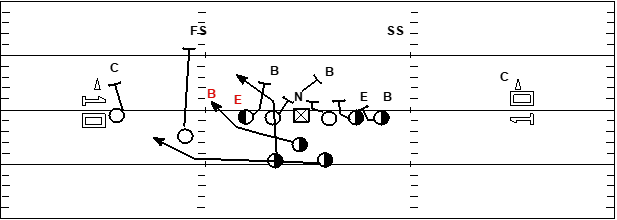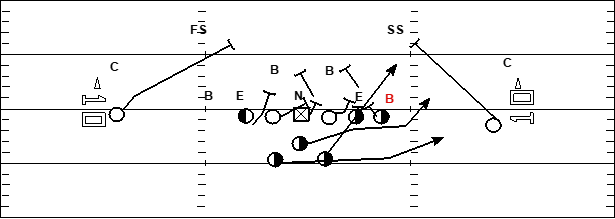Post #2 in a Series of Blogs on Gun Triple Option Concepts: Guest Blog Mark Grounds, Head Football Coach at Jacksonville High Scool, IL
Mark Grounds, Jacksonville High School, Illinois
In 2018 at Jacksonville High School, we went full tilt back to our triple option roots after more than a
decade of success as a single back spread team. During our “Spread” decade we still incorporated option
principles like zone read, zone midline, and power read. The beliefs in option football and its place in the
foundation of our program never left.
My first year at Jacksonville high school was 2001. Our school enrollment was 1265 students. The
next 15 years our community lost numerous well-paying blue-collar jobs as business either closed or
moved. Our 2018 enrollment was 925 students. In our conference the last 18 years has produced 13
state champions and 3 runner-up finishers. To compete with our size and athletes we have always felt
we needed to be a little different. All the teams in our league have become spread teams running the
same core plays. Most of the teams we face have superior depth of athletes so defenses don’t have to
change game plans week to week. We needed to be different again so after our 2017 season in which
we lost all 5 Qb’s in our program to season ending injuries by week 3, we made the decision to put the
spread genie in the bottle and return to being a full-time option team this past season.
Why the short gun Split backs
We started researching the short pistol flexbone that Ferris state and schools like Muskegon,
Michigan began using years ago. I was intrigued by the ability to run option football along with our
successful elements of our passing attack from one back sets. There were three issues I had when
putting this in that I couldn’t get past. The first was the pre-snap motion. We had a young team and a
young staff and the motion and tendencies presented from the flexbone gave us a lot of moving parts.
This made it difficult to have the efficiency we needed to have success.
The second problem that the short pistol flexbone presented us was the fact we had several true
tight end types and needed to feature a 3 man surface. This meant we have the ability to run my favorite
two plays in all of football which was outside veer and g-scheme belly. Both of those plays hit way too
slow from a fullback spot. These two plays along with not having presnap motion was why we decided
to run our triple from a split back set.
The third issue was why not go under center. In our town we fought the fight to get basketball kids
out. If the ball was still being snapped from the gun we were still spread, right? This was a cultural battle
I didn’t want to fight again if I didn’t have to. Besides, I feel there are some advantages of running
option from the gun.
Advantages of Short Gun Veer
Versatility-you can run from multiple sets featuring one, two or three backs
Its downhill- you don’t have to teach the getting away from the LOS, mesh and get back into the LOS. QB receives the snap and works to the line.
The speed of the veer is quicker than zone read and not much slower than under center veer.
Short QB can see the field.
You get to pitch phase more.
Passing angles are better.
Screen game is easier.
You can feature more designed QB runs.
You can play athletes at offensive line due to the ability to throw and run screens.
It is an every down, end-zone to end-zone offense.
Gives zone pass defenses and the triple is built in blitz control.
Featuring the triple give true play action potential which is tough for traditional spread teams.
Athletes and fans see it as spread.
Disadvantages of the short gun veer
The snap is the most important part of the entire equation. A bad snap can ruin the entire timing of the play.
The QB must see the snap instead of feel the snap from under center. This momentarily takes his eyes off the dive read.
You lose some deception that an under center offense can use.
QB sneak is not at your disposal.
QB depth
The QB has his heels at 3 ½ yds. from the center’s heels. This is the starting point. If you can be closer be closer. IF you need to back up, back up.
RB depth and alignment
RBs should have their heels at 5 yds. from the football, not 5 yds. from the center, or the QB. They align with their crotch on the inside leg of the guard. Two or three point stance can be used. I like the 3 point because the RB’s can stay low, and it gives a little deception to the defense.
Offensive line splits
Our base splits are 2 ½ yds between all the linemen. We recess off the ball. Adding width based off the play such as trap or midline isn’t a big tell or deal. We have messed with really wide splits and closed down the splits to 6 inches. It’s all based on what the ability of the linemen are.
The Center Snap
When putting this in we first went to the two handed snap that Ferris State taught. The ability of the center to move laterally made us go back to our single hand, dead ball snap. The center grips the tops of the ball with the laces to the QB’s throwing hand. He flips the ball with his hand hitting the middle of his body. IF he is scooping left he must step while snapping which has his hand hit the right inner thigh. The opposite technique will be used on scoop right.
The Triple option Mesh from the Short Gun
A real point of emphasis for us this year is the QB working back into the line on the mesh. Our Inside Veer is a ride and decide mesh. Ferris State teaches to pivot. We did that but the dive read can play both. We worked towards the line more on our success full reads. Our Outside Veer mesh is a point read where we turn and run at the read key. Our QB’s ran too flat instead of meeting the Rb closer to the line. This flat approach also allowed the defensive end to see the mesh better and play both. The following film depicts the problems with not working into the line.
In 2008 we were still running veer from the gun but aligned deeper so we had to work towards the line. This is what we really started to emphasize and it helped us.
Base Plays of the Short Gun Split Back Veer
Inside Veer
Outside Veer
Trap
G-Belly
Counter
We will run other plays but I will focus on these two triple option plays as well as our three main complementary plays. I think these complementary plays are important if the QB is having trouble reading, as well as it give them a mental break being able to hand the ball off. Trap is our a-gap complement, belly our b gap complement, and counter is our c-gap complement.
Inside Veer
QB- Pivot and ride, read first man on or outside the offensive tackle for dive, pitch off the first man who shows outside the dive read.
Dive back- aiming point is inside leg of the guard. Hug the double team. Hash marks, numbers, sideline.
Pitch back- 1x5 pitch relationship
Line- O.I.L. block. (On, Inside, LB)
V. 50 Front open side
V. 50 Front Tight Side
V. 40 Front
Outside Veer
QB- Turn and run pointing the ball at the offensive tackle. Work downhill. Read EMOL for dive or keep,
Dive back- aiming point is inside middle of the offensive tackle. Hug the double team. Hash marks, numbers, sideline.
Pitch back- 1x5 pitch relationship
Line- O.I.L. block. (On, Inside, LB)
V. 50 Front
V. 40 Front
G-Belly
This is a great complementary play and gives us the power essence to our offense. It’s a true block down, double and kick play. The QB and Rb mechanics are exactly the same as OV for us. You lose the deception of reversing out in the gun but it’s still an effective play.
V. 50 Front
V. 40 Front (we skin the cat tight around a 6! Or 7 tech defender to the ILB. IF our TE can down block the defensive end in c-gap, our guard will pull around tight for playside ILB.
Trap
In our trap we will only block two people on the LOS. The center picks for the puller and the guard kicks out the b-gap defender.
QB- open opposite the trap like running inside veer. Hand ball off and pivot playside and carry out counter option fake.
Dive back- aiming point is inside middle of the offensive tackle. Follow the pulling guard. Cut off the down blocking OT.
Pitch back- Rocker step. 1x5 pitch relationship
Line- All besides the center and pulling guard climb to first lb. inside your alignment. Get downfield!!
V. 50 Front
V. 40 Front
Counter Trey
Counter is run from a cross buck action. It is our C-gap complementary play. This play and the nuances of who and how to block can be debated. It wasn’t a great play this last year because of our size and speed of our offensive line. Counter trey and our trap are much more effective when we have athletes that can move and climb.
V. 50 Front
V. 40 Front
Conclusion
Going back to triple option as our base gave us a chance to win games with a young team. We started 14 sophomores last year and a true freshman the last game. If we were a spread team that threw the ball I don’t think we win a game. Going into this year with 19 returning starters, these are our point of emphasis:
Athletes up front. Don’t sacrifice size for athleticism
Work meshes downhill to the LOS
Run only what you can practice every day
Play action!!
If you have any question contact me at coachgrounds@gmail.com. Thanks for the opportunity to discuss what we do.











